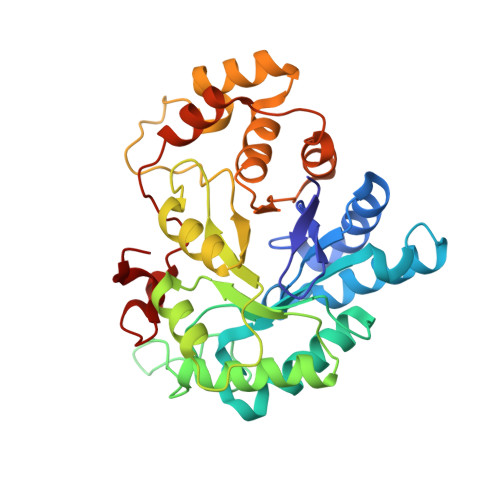The structure of Apo R268A human aldose reductase: Hinges and latches that control the kinetic mechanism
Bohren, K.M., Brownlee, J.M., Milne, A.C., Gabbay, K.H., Harrison, D.H.T.(2005) Biochim Biophys Acta 1748: 201-212
- PubMed: 15769597
- DOI: https://doi.org/10.1016/j.bbapap.2005.01.006
- Primary Citation of Related Structures:
1XGD - PubMed Abstract:
Aldose reductase (AR) catalyzes the NADPH-dependent reduction of glucose and other sugars to their respective sugar alcohols. The NADP+/NADPH exchange is the rate-limiting step for this enzyme and contributes in varying degrees to the catalytic rates of other aldo-keto reductase superfamily enzymes. The mutation of Arg268 to alanine in human recombinant AR removes one of the ligands of the C2-phosphate of NADP+ and markedly reduces the interaction of the apoenzyme with the nucleotide. The crystal structure of human R268A apo-aldose reductase determined to a resolution of 2.1 A is described. The R268A mutant enzyme has similar kinetic parameters to the wild-type enzyme for aldehyde substrates, yet has greatly reduced affinity for the nucleotide substrate which greatly facilitates its crystallization in the apoenzyme form. The apo-structure shows that a high temperature factor loop (between residues 214 and 226) is displaced by as much as 17 A in a rigid body fashion about Gly213 and Ser226 in the absence of the nucleotide cofactor as compared to the wild-type holoenzyme structure. Several factors act to stabilize the NADPH-holding loop in either the 'open' or 'closed' conformations: (1) the presence and interactions of the nucleotide cofactor, (2) the residues surrounding the Gly213 and Ser226 hinges which form unique hydrogen bonds in the 'open' or 'closed' structure, and (3) the Trp219 "latch" residue which interacts with an arginine residue, Arg293, in the 'open' conformation or with a cysteine residue, Cys298, in the 'closed' conformation. Several mutations in and around the high temperature factor loop are examined to elucidate the role of the loop in the mechanism by which aldose reductase binds and releases its nucleotide substrate.
Organizational Affiliation:
The Harry B. and Aileen Gordon Diabetes Research Laboratory, Molecular Diabetes and Metabolism Section, Department of Pediatrics, Baylor College of Medicine, Houston, TX, USA.














